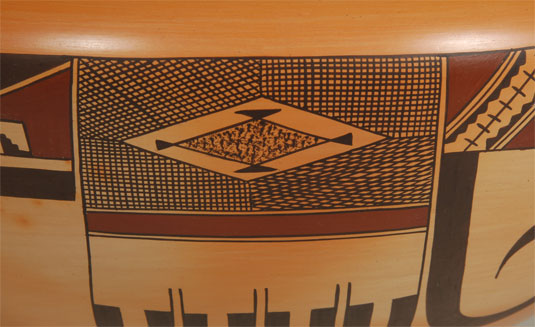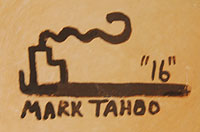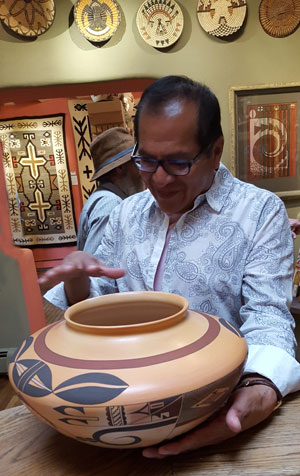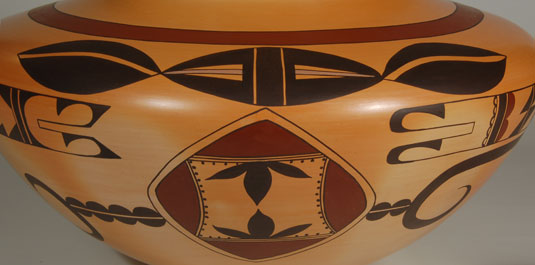Hopi Pueblo Very Large Polychrome Seed Jar [SOLD]
+ Add to my watchlist Forward to Friend
- Category: Modern
- Origin: Hopi Pueblo, Hopituh Shi-nu-mu
- Medium: clay, pigment
- Size: 7-3/4” height x 13-1/2” width
- Item # C3815 SOLD


Mark Tahbo came in during Santa Fe's Indian Market season and beamed with enthusiasm when he unpacked this large and magnificent jar. He hardly knew where to start telling us what he had in mind as he made it and which elements of design he chose. He walked us through each design element and I hope I can recall all he said and pass it on in this presentation.
First, he chose to make the jar from clay from the Sikyatki ruins. There are several clay sources around First Mesa and he selects clay from all of them on occasion. His next choice was a large vessel shape with a high shoulder and rolled our rim. It is easy to see that he achieved his desires in the vessel shape. Since he chose Sikyatki clay, it was obvious for him to choose Sikyatki designs.
 Mark explained that the three large oval black design elements on the shoulder represent the head of the female fertility katsina—Kokopellmana. The face is in the center on which he highlighted the eyes with a mauve color clay. The two outer black ovals represent the Hopi maiden whorl hair style. Below the center section is the mana’s reproduction center in which there are plant forms. The small circles expanding horizontally from this reproduction center represent the mana reaching out to the adjoining designs.
Mark explained that the three large oval black design elements on the shoulder represent the head of the female fertility katsina—Kokopellmana. The face is in the center on which he highlighted the eyes with a mauve color clay. The two outer black ovals represent the Hopi maiden whorl hair style. Below the center section is the mana’s reproduction center in which there are plant forms. The small circles expanding horizontally from this reproduction center represent the mana reaching out to the adjoining designs.
What may appear to be the main design is a more traditional Sikyatki panel often seen in varying form by Nampeyo. The rectangular block near the shoulder is filled with fine black lines crossing and crisscrossing each other in parallel and diagonal form. The center of the rectangle houses a diamond full of stippling. Four eagle tail feathers are suspended downward.
The deep red color chosen for this jar is not from a clay source but is from a rock. Mark crushes it to form a paint. He stated than it is watery and thin and has to be applied a number of times to achieve the dark thick consistency seen here.
In order to achieve a strong orange blush to the surface, Mark increased the heat of the firing by using coal and, in doing so, a very small chip popped out at the rim. It has been professionally repaired and is not at all noticeable and the location is not discernable.
Condition: excellent condition with a small chip professionally repaired.
Provenance: from the artist
Recommended Reading: Hopi-Tewa Pottery: 500 Artist Biographies by Gregory and Angie Schaaf

- Category: Modern
- Origin: Hopi Pueblo, Hopituh Shi-nu-mu
- Medium: clay, pigment
- Size: 7-3/4” height x 13-1/2” width
- Item # C3815 SOLD



